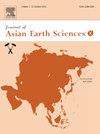孟加拉国Barind和Madhupur粘土地层中红粘土的矿物学和物源:构造环境和化学风化的意义
IF 2.3
Q3 GEOSCIENCES, MULTIDISCIPLINARY
引用次数: 0
摘要
本文研究了孟加拉盆地Barind和Madhupur粘土组的地球化学和矿物学特征,重点研究了它们的物源、构造背景和风化过程与区域地质演化的关系。采用粒度分布、x射线衍射(XRD)、x射线荧光(XRF)、原子吸收光谱(AAS)和地球化学风化指标等技术分析了红粘土的矿物学、化学和重金属特征。粒度分布表明,受成土作用和风化作用的影响,土壤主要由细粒粉砂组成(约80%),含有少量粘土和砂。矿物学分析显示,石英、高岭石、伊利石、绿泥石和氧化铁占主导地位,表明在潮湿、寒冷的更新世气候下,风化变质岩和沉积岩混合在一起,风化强烈。地球化学数据显示SiO2含量高,矿物学成分成熟,属石英富源岩。主成分分析(PCA)指出了广泛的风化作用,特别是基性岩石。化学蚀变指数(CIA)值介于70.93% ~ 90.80%之间,为中度至强烈风化。微量金属浓度低于大陆上地壳平均水平,表明风化作用长期存在。这些发现强调了潮湿、寒冷的气候和构造环境在塑造孟加拉盆地更新世景观中的作用。该研究推进了区域古气候重建,强调了喜马拉雅侵蚀、河流运输和化学风化在形成独特的红粘土土中的相互作用。未来的工作应结合同位素示踪来完善沉积物来源分配和气候模式。本文章由计算机程序翻译,如有差异,请以英文原文为准。

Mineralogy and provenance of red clay soils in Barind and Madhupur clay formations, Bangladesh: Implications for tectonic setting and chemical weathering
This study investigates the geochemical and mineralogical properties of the Barind and Madhupur clay formations in the Bengal Basin, focusing on their provenance, tectonic setting and weathering processes in relation to regional geological evolution. Several techniques such as particle size distribution, X-ray diffraction (XRD), X-ray fluorescence (XRF), atomic absorption spectrometry (AAS) and geochemical weathering indices were applied to analyze the mineralogical, chemical and heavy metal characteristics of red clay soils. The particle size distribution reveals that the soil consists predominantly of fine-grained silt (∼80 %), with minor amounts of clay and sand, influenced by pedogenesis and weathering processes. Mineralogical analysis reveals dominance of quartz, kaolinite, illite, chlorite and iron oxides, suggesting a mix of weathered metamorphic and sedimentary rocks and intense weathering in a humid, cold Pleistocene climate. Geochemical data show high concentrations of SiO2, indicating a quartz-rich source with a mature mineralogical composition. Principal component analysis (PCA) points to extensive weathering, particularly of mafic rocks. Chemical index of alteration (CIA) values ranges from 70.93 % to 90.80 %, indicating moderate to intense weathering. Trace metal concentrations are lower than the average Upper Continental Crust, suggesting long-term weathering. These findings underscore the role of humid, cold climates and tectonic setting in shaping the Bengal Basin’s Pleistocene landscapes. The study advances regional paleoclimatic reconstructions and highlights the interplay of Himalayan erosion, fluvial transport and chemical weathering in producing the distinctive red clay soils. Future work should integrate isotopic tracing to refine sediment source apportionment and climatic models.
求助全文
通过发布文献求助,成功后即可免费获取论文全文。
去求助
来源期刊

Journal of Asian Earth Sciences: X
Earth and Planetary Sciences-Earth-Surface Processes
CiteScore
3.40
自引率
0.00%
发文量
53
审稿时长
28 weeks
 求助内容:
求助内容: 应助结果提醒方式:
应助结果提醒方式:


